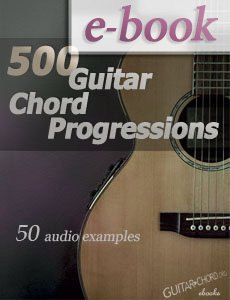Mixolydian mode chord chart
Mixolydian mode differs with one note from the major scale, something that affects the iii chord and V chord primarily in chord progressions. In addition, there are some differences on how this mode is used then creating progressions. For example, the I chord often turns into a I7 chord.
The first table with chords shows the relationship of all triads in this mode. The first column shows the key note of the mode and on the same row the other chords that fits together with it.
Chords in Mixolydian modes
| I | ii | iii | IV | v | vi | VII |
|---|---|---|---|---|---|---|
| C# | D#m | Fdim | F# | G#m | A#m | B |
| F# | G#m | A#dim | B | C#m | D#m | E |
| B | C#m | D#dim | E | F#m | G#m | A |
| E | F#m | G#dim | A | Bm | C#m | D |
| A | Bm | C#dim | D | Em | F#m | G |
| D | Em | F#dim | G | Am | Bm | C |
| G | Am | Bdim | C | Dm | Em | F |
| C | Dm | Edim | F | Gm | Am | Bb |
| F | Gm | Adim | Bb | Cm | Dm | Eb |
| Bb | Cm | Ddim | Eb | Fm | Gm | Ab |
| Eb | Fm | Gdim | Ab | Bbm | Cm | Db |
| Ab | Bbm | Cdim | Db | Ebm | Fm | Gb |
| Db | Ebm | Fdim | Gb | Abm | Bbm | B |
| Gb | Abm | Bbdim | B | Dbm | Ebm | E |
| Cb | Dbm | Ebdim | E | Gbm | Abm | A |
Mixolydian chord progressions
Here are chord progressions based on the Mixolydian mode:
Dm - Gm - C7 (C Mixolydian)
Fm - C - G7 (G Mixolydian)
D - A - E (E Mixolydian)
A - D - E - A - G - D (A Mixolydian)
Mixolydian is closed related to Major and Minor keys and the progressions are not often "Mixodydian-specific" so to say. The progressions above could also apply to major and minor keys.
Four-note chords in Mixolydian modes
| I | ii | iii | IV | v | vi | VII |
|---|---|---|---|---|---|---|
| C#7 | D#m7 | Fm7b5 | F#maj7 | G#m7 | A#m7 | Bmaj7 |
| F#7 | G#m7 | A#m7b5 | Bmaj7 | C#m7 | D#m7 | Emaj7 |
| B7 | C#m7 | D#m7b5 | Emaj7 | F#m7 | G#m7 | Amaj7 |
| E7 | F#m7 | G#m7b5 | Amaj7 | Bm7 | C#m7 | Dmaj7 |
| A7 | Bm7 | C#m7b5 | Dmaj7 | Em7 | F#m7 | Gmaj7 |
| D7 | Em7 | F#m7b5 | Gmaj7 | Am7 | Bm7 | Cmaj7 |
| G7 | Am7 | Bm7b5 | Cmaj7 | Dm7 | Em7 | Fmaj7 |
| C7 | Dm7 | Em7b5 | Fmaj7 | Gm7 | Am7 | Bbmaj7 |
| F7 | Gm7 | Am7b5 | Bbmaj7 | Cm7 | Dm7 | Ebmaj7 |
| Bb7 | Cm7 | Dm7b5 | Ebmaj7 | Fm7 | Gm7 | Abmaj7 |
| Eb7 | Fm7 | Gm7b5 | Abmaj7 | Bbm7 | Cm7 | Dbmaj7 |
| Ab7 | Bbm7 | Cm7b5 | Dbmaj7 | Ebm7 | Fm7 | Gbmaj7 |
| Db7 | Ebm7 | Fm7b5 | Gbmaj7 | Abm7 | Bbm7 | Bmaj7 |
| Gb7 | Abm7 | Bm7b5 | Bmaj7 | Dbm7 | Ebm7 | Emaj7 |
| Cb7 | Dbm7 | Ebm7b5 | Emaj7 | Gbm7 | Abm7 | Amaj7 |
Comments
The four-note chords in the second table are not the only possible four-note chords based on the Mixolydian, and it can of course be extended to five-note chords as well. The I chord, for example can also be 9th or 11th; the ii chord can also be m9 and m11; the IV chord can also be maj9 and maj13; the v chord can also be m9 and m11; the VII chord can also be 6/9 and maj9.
Some chord progressions including extended Mixolydian based chords:
C7 - Dm9 - Bmaj7 - Fmaj7 (C Mixolydian)
Am7 - Cmaj7 - D7 (D Mixolydian)
E7 - Amaj7 - D6 (E Mixolydian)
Dm7 - Em7 - G7 (G Mixolydian)
Dmaj7 - F#m7 - A7 (A Mixolydian)
The diminished iii degree is not used often in Mixolydian progressions because it can fool the ear to hear the IV degree as the tonal center. One option is to altered it with a III7:
C - E7 - Am7 - Fmaj7 (C Mixolydian)
Another possible alteration is to change the v degree to a V7 (once again for increase the feeling of the tonal center, the I chord that is):
C7 - Dm7 - G7 - C7 (C Mixolydian)
See also:
Lydian mode chord chart
Phrygian mode chord chart
Pentatonic scales chord chart
